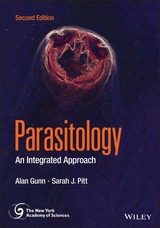
Parasitology – An Integrated Approach
John Wiley & Sons Inc (Verlag)
9780470684238 (ISBN)
- Titel ist leider vergriffen;
keine Neuauflage - Artikel merken
Alan Gunn Liverpool John Moores University, Liverpool, UK Sarah J. Pitt University of Brighton, UK Brighton and Sussex University Hospitals NHS Trust, Brighton, UK
Preface xiii 1 Animal associations 1 1.1 Introduction 1 1.2 Animal associations 1 1.3 Parasite hosts 11 1.4 The co-evolution of parasites and their hosts 13 1.5 Parasitism as a 'lifestyle': advantages and limitations 16 1.6 The economic cost of parasitic diseases 18 1.7 Why parasitic diseases remain a problem 21 1.8 Taxonomy 24 2 Parasitic protozoa, fungi and plants 28 2.1 Introduction 28 2.2 Parasitic protozoa 28 2.3 Phylum Rhizopoda 29 2.4 Phylum Metamonada 34 2.5 Phylum Apicomplexa 40 2.6 Subclass Coccidiasina 50 2.7 Phylum Kinetoplastida 62 2.8 Phylum Chlorophyta 81 2.9 Kingdom fungi 83 2.10 Kingdom plantae 85 3 Helminth parasites 86 3.1 Introduction: invertebrate taxonomy 86 3.2 Phylum Platyhelminthes 87 3.3 Class Trematoda 87 3.4 Class Cestoda 103 3.5 Phylum Acanthocephala 112 3.6 Phylum Nematoda (Nemata) 114 4 Arthropod parasites 137 4.1 Introduction 137 4.2 Phylum Chelicerata 138 4.3 Phylum Crustacea 148 4.4 Sub-phylum Hexapoda 153 5 Parasite transmission 180 5.1 Introduction 180 5.2 Contaminative transmission 181 5.3 Transmission associated with reproduction 184 5.4 Autoinfection 189 5.5 Nosocomial transmission 190 5.6 Active parasite transmission 191 5.7 Hosts and vectors 192 5.8 Host factors 196 5.9 Co-transmission and interactions between infectious agents 199 5.10 How religion can influence parasite transmission 202 5.11 The influence of war on parasite transmission 204 5.12 The influence of parasites on host behaviour 205 5.13 Environmental factors 207 6 Immune reactions to parasitic infections 212 6.1 Introduction 212 6.2 Invertebrate immunity 213 6.3 Vertebrate immunity 215 6.4 Innate immunity to parasitic infection 221 6.5 Adaptive immunity 226 6.6 Immunity to malaria 233 6.7 Schistosoma mansoni and Hepatitis C virus interactions 237 6.8 HIV-AIDS and parasitic disease 238 7 Pathology 245 7.1 Introduction 245 7.2 Factors that influence pathogenesis 245 7.3 Mechanisms by which parasites induce pathology 247 7.4 Types of pathology 250 7.5 Damage to specific organs 269 7.6 Co-infections and pathogenesis 289 8 The useful parasite 292 8.1 Introduction: the goodness of parasites? 292 8.2 The importance of parasites for the maintenance of a healthy immune system 293 8.3 The use of parasites to treat medical conditions 297 8.4 Parasites as sources of novel pharmaceutically-active compounds 308 8.5 Parasites as biological control agents 309 8.6 Parasites as forensic indicators 312 9 Identification of protozoan and helminth parasites 316 9.1 Introduction 316 9.2 The importance of correct identification 316 9.3 Properties of an ideal diagnostic test 318 9.4 Isolation of parasites 320 9.5 Identification from gross morphology 323 9.6 Biochemical techniques 329 9.7 Immunological techniques 329 9.8 Molecular techniques 331 9.9 Rapid diagnostic tests (RDTs) 334 9.10 MALDI-TOF MS 337 10 Parasite treatment and control 339 10.1 Introduction 339 10.2 Importance of understanding parasite life cycles for effective treatment and control 339 10.3 Treatment of parasitic diseases 341 10.4 Vaccines against parasitic diseases 356 10.5 Control of parasitic diseases 362 References 375 Index 431
| Verlagsort | New York |
|---|---|
| Sprache | englisch |
| Maße | 191 x 251 mm |
| Gewicht | 1036 g |
| Themenwelt | Naturwissenschaften ► Biologie ► Mikrobiologie / Immunologie |
| ISBN-13 | 9780470684238 / 9780470684238 |
| Zustand | Neuware |
| Informationen gemäß Produktsicherheitsverordnung (GPSR) | |
| Haben Sie eine Frage zum Produkt? |
aus dem Bereich



